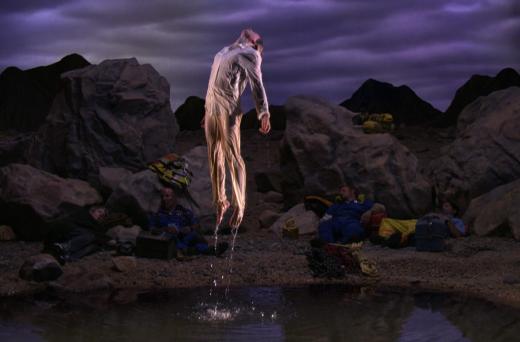GOING FORTH BY DAY
Going Forth By Day is a five-part projected digital-image cycle that explores themes of human existence: individuality, society, death, rebirth. The work is experienced architecturally, with all five image sequences playing simultaneously in one large gallery. To enter the space, visitors must literally step into the light of the first image. Once inside, they stand at the center of an image-sound world with projections on every wall. The story told by each panel is embedded within the larger narrative cycle of the room. Viewers are free to move around the space to watch each image panel individually or to stand back and experience the piece as a whole.
The five image sequences are each approximately thirty minutes in length and play in synchronization on a continuous loop. Sound from each panel mixes freely in the space, creating an overall acoustic ambience. The images are projected directly onto the walls—without screens or framed supports—as in Italian Renaissance frescoes, where the paint was applied directly into the plaster surface of the walls. The title of the work derives from a literal translation of the title of the Egyptian Book of the Dead, “The Book of Going Forth by Day”—a guide for the soul once it is freed from the darkness of the body to finally “go forth by the light of day.”
Fire Birth (1)
A human form emerges from a dim submerged world. The body swims in the fluid of an unconscious state between death and rebirth. Orange rays of light penetrate the surface of the water, coming from the previous world, which ended in fire. Now, illuminated by the light of prior destruction, the human essence searches for a way through this new underwater realm. It seeks the material form and substance necessary for its rebirth.
The Path (2)
It is the time of the summer solstice high in the mountains. The early morning light reveals a steady stream of people moving along a path through the forest. They come from all walks of life, each traveling at their own pace in their own unique way. There is no beginning or end to the procession of individuals—they have been walking long before we see them here, and they will be walking long after they leave our view. The constant flow of people suggests no apparent order or sequence. As travelers on the road, they move in an intermediate space between two worlds. A small marker in the forest grants them safe passage through this vulnerable state. There is no going back. They move constantly forward, driven toward an unknown destination.
The Deluge (3)
A stone building, newly restored, stands in the clear light of the autumnal equinox. People move along the street immersed in the flow of everyday events. Small incidents play out, affecting individual lives. Families are leaving their homes, people on the street are carrying personal possessions, and all actions become colored by an increasing tension in the community. Moments of compassion and kindness circulate within a mounting concern for individual survival.
When a warning is sounded for all to hear, a final moment of panic ensues on the street as individuals rush to save themselves. The last ones, in denial of the inevitable, have waited too long in the security of their own homes. Now they must run for their lives as the deluge strikes with full force at the very heart of their private world. They rush out of the building when it is suddenly flooded from within by a raging torrent of water. Individual lives and personal possessions are arbitrarily chosen to be lost in the process. Finally the violence and fury subsides as the surging water slowly recedes, leaving the building unharmed and the street washed clean. The empty sidewalk glistens in the midday sun.
The Voyage (4)
It is late afternoon at the time of the winter solstice. A small house stands on a hill overlooking the inland sea. Inside, an old man lies ill on a bed, attended by his son and daughter-in-law. Outside, another man sits by the door keeping vigil. Down by the shore, a boat is slowly being loaded with the personal possessions from the dying man’s home. An old woman waits patiently nearby.
After some time, the son and daughter-in-law must depart, leaving the old man alone with his dreams and fading breath. His house, container of lives and memories, is closed and locked. Soon after, the old man reappears on the shore and is greeted by his wife, who has been waiting for his arrival. The two board the boat, which departs, carrying them and their belongings to the distant Isles of the Blessed.
First Light (5)
It is dawn on the morning of the vernal equinox. A team of rescue workers has been laboring all night to save people caught in a massive flash flood in the desert. Exhausted and physically drained, they slowly pack up their equipment as the dawn light gradually builds and the emotional impact of the night’s events deepens. A woman stands on the shore, looking off into the flooded valley where her friends and neighbors once lived. She silently waits, filled with fear and fading hope for the fate of a loved one, her son, who will never return.

